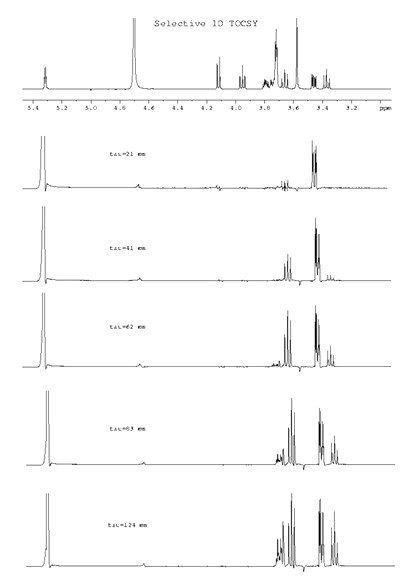TOCSY
TOCSY (Total Correlation Spectroscopy) creates correlations between all protons within a given spin system, not just between geminal or vicinal protons as in COSY. Correlations are seen between distant protons as long as there are couplings between every intervening proton. This is extremely useful for identifying protons on sugar rings or amino acids: All protons on a given sugar ring will have a correlation with all other protons on the same ring but not with protons on different rings.
Magnetization is transferred successively over up to 5 or 6 bonds as long as successive protons are coupled. Transfer is interrupted by small or zero proton-proton couplings. The presence of hetero-atoms, such as oxygen, usually disrupts TOCSY transfer. The number of transfer steps can be adjusted by changing the spin-lock time. A short time such as 20ms will give only one-step transfers and its TOCSY spectrum will be very similar to its COSY spectrum. More usefully, a long spin-lock time such as 80ms or 120ms will give up to 5 or 6-step transfers. The number of transfers depends on exact coupling details. A useful paper detailing TOCSY transfer in various sugars is Gheysen, K. et. al., Chem. Eur. J. 2008, 14, 8869-8878.
Shown below is a 400 MHz spectrum of sucrose. The red circles show the connections between proton 4 and all the other protons of the glucose ring.
1D TOCSY (Total correlation spectroscopy), like 2D TOCSY gives correlations between all protons within a given spin system. In 1D TOCSY, one peak is selected and signal is transferred from it to to all J-coupled protons in a stepwise process. Instead of cross peaks, magnetization transfer is seen as increased multiplet intensity.
Shown below is a series of selective TOCSY spectra of sucrose where the anomeric proton (5.3 ppm) has been selected and the mixing time and, thus, the number of transfers, has been changed. In the top spectrum (21 ms mixing) only 1-2 step transfer is seen. At longer mixing times, progressively more transfers are seen. The 1D version can be used to give sub-spectra of only protons coupled to the chosen, irradiated peak.
